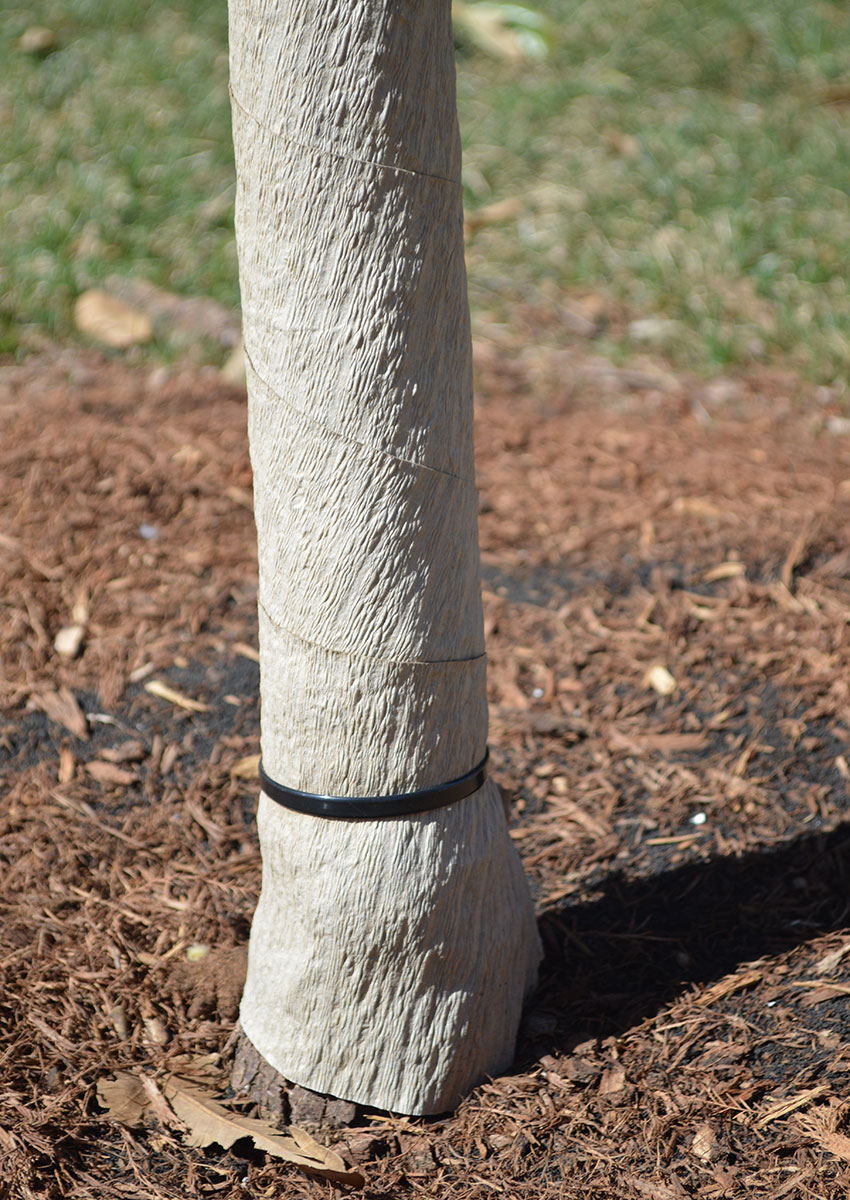
Extreme temperature fluctuations in winter are common on the Southern Plains and can cause damage to young trees. Alternate freezing and thawing of water in the trunk can cause cracks in the bark, opening the tree to infection. This problem is commonly called southwest winter injury because it typically occurs on the southwestern portion of the trunk, which tends to experience the greatest temperature swings as the warm afternoon sun strikes the trunk. Another name for this type of damage is sunscald.
Trees susceptible to sunscald
Deciduous trees with smooth bark and young, thin-barked trees are most susceptible to sunscald. Smooth-barked trees include maple (Acer spp. and cvs., Zones 3–9), tulip tree (Liriodendron tulipifera, Zones 4–9), birch (Betula spp. and cvs., Zones 2–7), and many fruit trees. Most young, newly planted trees have thin bark and benefit from a trunk wrap in late fall to protect against injury. While most species develop thicker bark as they age, some trees with dark bark, like peaches and plums, will continue to be susceptible to sunscald. Evergreen trees are not susceptible, because branches shade the trunk in winter.

How to protect trees against sunscald
Several commercial products are available to protect trunks against winter injury. These are made of plastic, paper, or polypropylene fabric. I prefer paper wraps, as they produce less waste and look more natural in the landscape. Paper wraps are made of thick, crinkled craft paper that has a little stretch to it. To apply paper tree wraps, simply wrap the paper around the trunk, beginning at the base and overlapping as you work your way up to the first branch. Apply the paper loosely as you work. Secure the tops and bottoms with a zip tie, tape, or twine. Polypropylene wraps are applied in a similar manner. If you are using a plastic trunk guard, make sure it is loosely fitting and has holes or slits for good air circulation.

When to apply tree wraps
Young trees benefit from tree wraps for the first two winters as they become established and develop thicker bark. The susceptible trees mentioned above will benefit from wrapping during the first five years or until the bark develops texture. Apply trunk wraps in October, and leave them in place until March. It is important to remove tree wraps in spring prior to growth. During spring growth, the trunk expands as water moves up the trunk. Wraps applied too tightly or left on during this time can cause constriction in the trunk. Pay attention to any zip ties or other fasteners as well. It is crucial to remove these to avoid girdling the trunk.

Winter pest protection
Rabbits, rodents, and deer also cause damage to tree trunks, especially in winter. You can protect against this type of damage by installing a small wire mesh cylinder around the trunk. Set the mesh cage an inch or so from the trunk so mammals cannot feed through the openings. It is important to check the spacing regularly to make sure the trunk has not outgrown the cage. Bury the bottom several inches of the cage below the soil line to prevent animals from burrowing underneath.
Winter tree maintenance
Keep trees well irrigated going into the winter season. Stressed trees are more susceptible to sunscald. Give trees a fresh blanket of mulch to maintain soil moisture over the winter, and water trees and shrubs at least once per month during the winter months in the absence of sufficient rain or snowfall.
—Kim Toscano is a horticulturalist based in Stillwater, Oklahoma. She previously hosted Oklahoma Gardening, a weekly PBS television program produced by the Oklahoma Cooperative Extension Service.
Fine Gardening Recommended Products

Greenworks 40V (185 MPH / 340 CFM / 75+ Compatible Tools) Cordless Brushless Leaf Blower / Vacuum, 4.0Ah Battery and Charger Included
Fine Gardening receives a commission for items purchased through links on this site, including Amazon Associates and other affiliate advertising programs.

A.M. Leonard Deluxe Soil Knife & Leather Sheath Combo
Fine Gardening receives a commission for items purchased through links on this site, including Amazon Associates and other affiliate advertising programs.

Medium Nut Wizard 14" for English Walnuts, Chestnuts, Golf Balls
Fine Gardening receives a commission for items purchased through links on this site, including Amazon Associates and other affiliate advertising programs.



















Comments
Log in or create an account to post a comment.
Sign up Log in